If you want to play lead guitar, then learning the minor pentatonic scale is one of the best places to start.
The minor pentatonic scale is by far the most commonly occurring scale in blues and rock music.
It has been used to craft a huge number of famous riffs and guitar solos, and was used extensively by some of the most notable blues and blues rock guitarists of all time.
This includes Eric Clapton, Stevie Ray Vaughan, Gary Moore, Jimmy Page, Albert King, Peter Green and Jimi Hendrix, amongst countless others.
So if you want to recreate the approach of these guitarists and play lead guitar in a blues or rock style, the minor pentatonic scale will be integral to your playing.
If this material is totally new to you, then the good news is that getting to grips with the minor pentatonic scale is quite straight forward.
And in even better news, properly understanding how the scale works will allow you to solo confidently in a range of different styles. You can really sound amazing as a lead guitarist by using nothing more than the minor pentatonic scale.
If you are interested in playing lead guitar then, and you are looking for the best place to start, in this article I outline everything you need to know about the minor pentatonic scale. I cover:
- The shapes of the minor pentatonic scale and how to play them
- How to play these shapes in a range of different keys
- The easiest ways to learn and practice the minor pentatonic scale
- Examples of famous songs that utilise the minor pentatonic scale
Without further ado then, here is everything you need to know about the minor pentatonic scale:
Scale theory
Before we dive in and start looking at how to play the minor pentatonic scale, it is first worth covering the basics of how the scale is constructed.
Don’t worry – I won’t get too deep into music theory here; I will just cover the essentials.
This will help to give you a greater understanding of what you are actually playing, which is important.
The minor pentatonic scale is a 5 note scale (the word penta being derived from the Greek word for 5), and there are 5 different shapes of the scale – each one built from one of those 5 notes.
The notes of the scale are taken from the natural minor scale, which is a 7 note scale.
So the minor pentatonic scale contains notes from the natural minor scale, but it contains only 5, rather than 7 notes.
In the key of A, which we will be using for the examples in this article, the notes that appear in the A natural minor scale are as follows:
A B C D E F G
The intervals that appear within that scale are as follows:
1 2 b3 4 5 b6 b7
Conversely, the notes that appear within the minor pentatonic scale are as follows:
A C D E G
The intervals that appear within that scale are as follows:
1 b3 4 5 b7
As you can hopefully see then, the minor pentatonic scale contains the same notes and intervals as the natural minor scale. The only difference is that it contains only 5, rather than 7 notes.
You don’t need to worry too much about the natural minor scale for now. This is a scale that you will encounter a little later on in your blues guitar playing journey.
However at this stage it is useful to appreciate that the minor pentatonic scale is closely related to the natural minor scale.
You also don’t need to worry too much about these intervals for now. They are simply a musical way of expressing the distances between the notes in the scale.
However as you become a little more advanced, you will encounter intervals more frequently. As such, it is good to get accustomed to them early on.
If you would like a little more information on them at this stage, I would recommend reading my article entitled: An Introduction To Intervals For Guitar Players.
I run through exactly what intervals are and cover them in great detail.
Minor pentatonic scale shapes
Now though, we can turn our attention to the shapes of the minor pentatonic scale.
There are 5 of these different shapes, which you can play in different positions on the fretboard.
These shapes remain the same regardless of which different key you are playing in. The only difference is the position on the neck where you play them.
In other words, you find the same shapes in the A minor pentatonic scale as you do in the key of B minor or D minor. The only difference is where you play the shapes on the neck.
Don’t worry if this sounds confusing – I cover it in a lot more detail below.
For now though, all you need to know is that once you have learnt the different shapes of the minor pentatonic scale, you will be able to move them around the neck and solo in a whole range of different keys.
So the good news is that learning the 5 shapes of the minor pentatonic scale will unlock the fretboard for you.
Below then, I have outlined the 5 shapes of the minor pentatonic scale.
Here I have used the key of A minor as an example. This is one of the most commonly used keys in blues and blues rock, and so it is a great place for us to start.
The shapes below are illustrated using scale diagrams, which are nice and easy to read:
- The circles represent the notes that you need to play
- The light blue circles show the tonic notes in the scale. In the examples below, the tonic notes are the notes of ‘A’
- The numbers within the circles show the fingers of your fretting hand that you I would recommend using to play the notes
If you look at the fingerings for these shapes in isolation, you might think that there are better or more comfortable shapes that you could use.
Yet despite that, I would urge you to try the ones I have suggested below. These shapes put your hands into the best position when bending and soloing using the minor pentatonic scale.
They also put your hand into the best position for when you start to play the blues scale (which adds a number of additional notes to the minor pentatonic scale).
I cover the blues scale in more detail in this article here, and in this full video course here.
For now though, let’s look at the 5 shapes of the minor pentatonic scale:
Shape 1

This is what the tablature version of the above shape looks like:

And if you play this shape using eighth notes at 80 beats per minute (BPM), this is what it sounds like:
This is the easiest and most recognisable shape of the minor pentatonic scale. It is a nice and symmetrical shape and one that you can use to create a whole range of beautiful blues and rock licks.
Shape 2
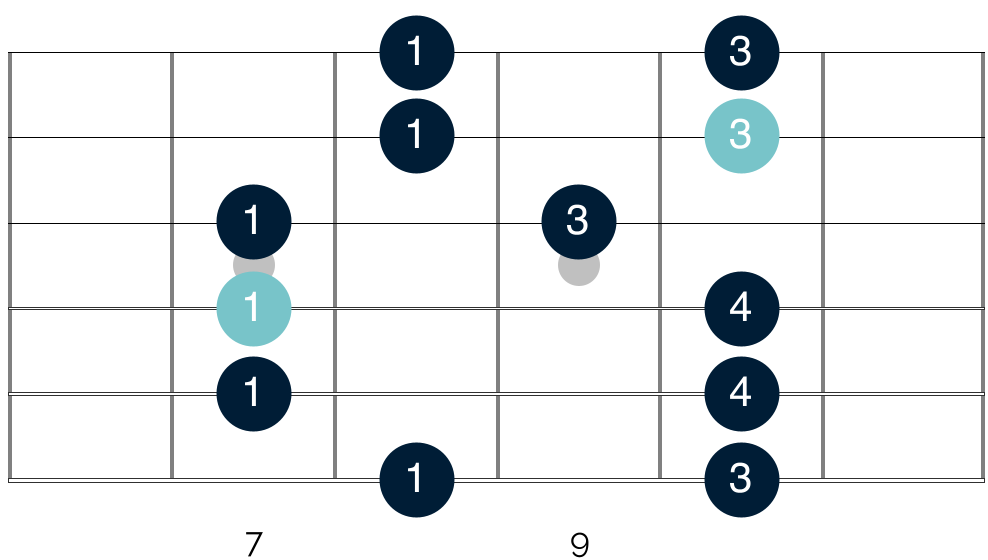
This is what the tablature version of the above shape looks like:

If you play this shape using eighth notes at 80 beats per minute (BPM), this is what it sounds like:
Like the first shape of the minor pentatonic, shape 2 is quite easy to memorise.
This is because it connects neatly with the first shape. This allows you to move between the 2 different shapes with ease and create a variety of interesting licks that combine the 2 scale shapes.
Shape 3
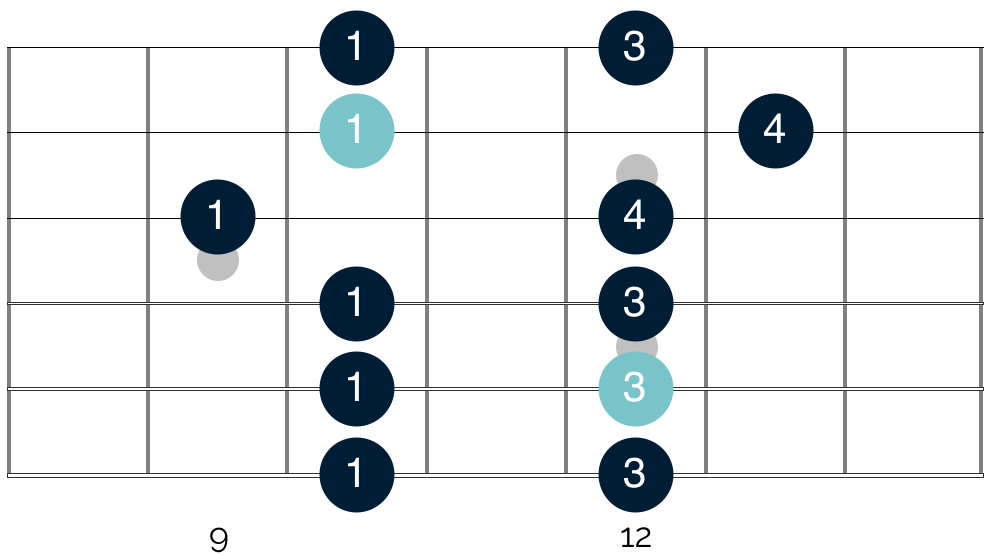
This is what the tablature version of the above shape looks like:

If you play this shape using eighth notes at 80 beats per minute (BPM), this is what it sounds like:
Shape 3 is a little bit trickier to remember. This is because you have to shift your hand up 1 fret (a semitone) on your B string to account for the idiosyncrasies of your guitar’s tuning.
As a result, this position is one that can take a little longer to learn.
Stick with it though.
Not only can you create some amazing licks using this shape, you can also combine it with a number of different scale shapes to great effect (which I will cover in greater detail in a future article).
Shape 4

This is what the tablature version of the above shape looks like:

If you play this shape using eighth notes at 80 beats per minute (BPM), this is what it sounds like:
Like shape 3, this shape of the scale is a little more challenging to learn. This is because of the small shift you have to make with your hand on the B string.
Again though, stick with it. You can create some beautiful licks in this position – particularly on the top 2 strings.
Shape 5
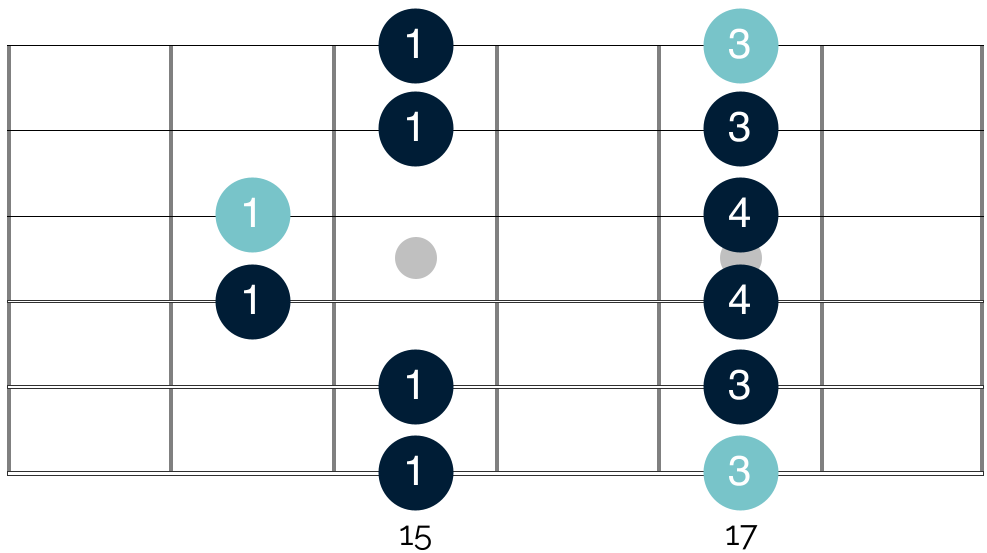
This is what the tablature version of the above shape looks like:

If you play this shape using eighth notes at 80 beats per minute (BPM), this is what it sounds like:
Like the first shape listed above, this final shape of the minor pentatonic scale is nice and symmetrical, which makes it easy to remember.
Having said that, this shape is often underutilised. This is because it is not as easy to create licks with this shape as it is with some of the others listed here.
That is not to say you shouldn’t use it though. Once you get to grips with the shape, you can use it to transition smoothly between other shapes in the scale.
You can also use it to create some slightly different and interesting sounding blues licks.
Recapping the minor pentatonic scale shapes
If you put all of these shapes together, then you end up with the following 5 scale shapes in the key of A minor:
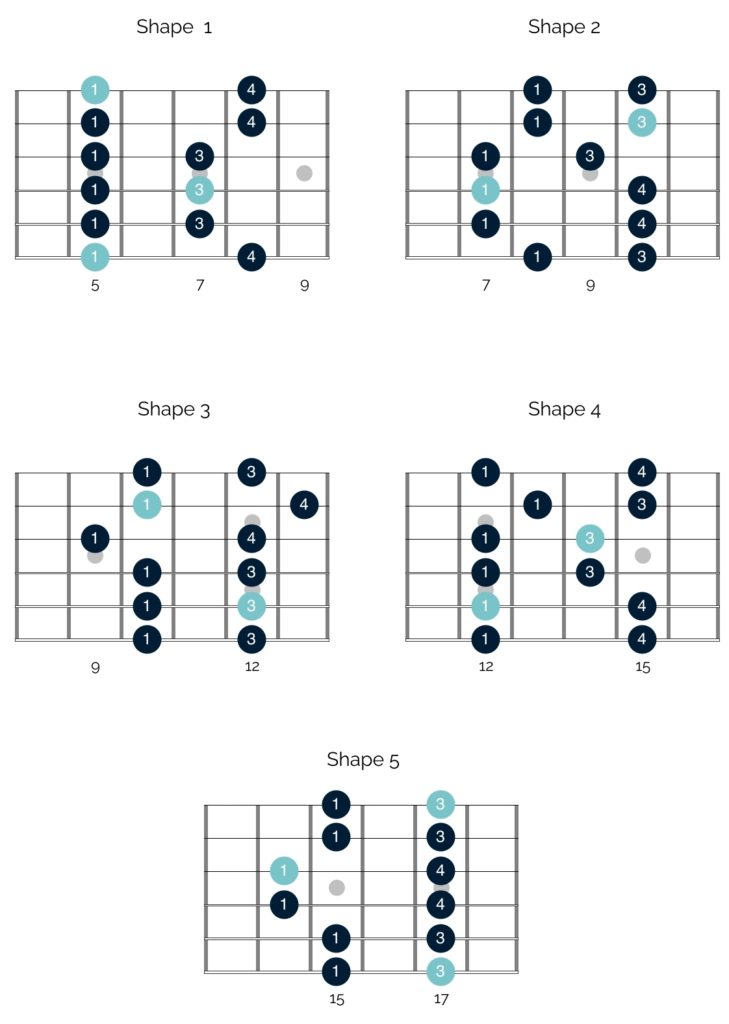
The notes outlined in light blue are the tonic notes. In the key of A minor, these are all the notes of ‘A’. These tonic notes are different when you are playing in a different key (more on this below).
Learning the minor pentatonic scale shapes
When it comes to learning guitar, there is no secret or magic bullet; you just have to keep playing and applying yourself consistently.
The aim here is to learn and consolidate the shapes of the minor pentatonic scale. So don’t treat this like a technical exercise.
You should not be trying to play these shapes quickly. Take your time over them and just work on really getting to grips with the shapes and notes.
Once you have them nailed, you can then start to look at exercises that will help you build your rhythm and technique. And I cover these in more detail below.
Before you look at those though, it is important that you get comfortable with playing these shapes, and also with playing them out of order.
As such, this is how I would recommend learning the shapes of the minor pentatonic scale:
- Start by playing shape 1. Pause, and then move on to shape 2. Repeat this, until you have played up to shape 5
- When you get to shape 5, pause and then work your way back through the shapes in reverse. So start with shape 5 and play back down through the shapes until you arrive back at shape 1
- Once you have reached the point where you can play up and down the shapes like this without pausing or having to think too much about the notes, push yourself to play them out of order.
Jump straight to shape 3 and play the scale in that position. Pause, then jump to shape 5. Pause and then jump down to shape 2.
This will help you to memorise the different scale shapes in a way that is more applicable to a real world playing or improvising situation
Typically, I find that shapes 3 and 4 of the minor pentatonic scale are the most difficult to remember. So don’t be disheartened if you struggle to learn them at first.
Just keep on playing them and spend some time every day (even if it is only 10 minutes!) committing the shapes to memory.
Beyond the 5 minor pentatonic shapes
Once you have learnt the 5 shapes as listed above, there is one further step to take. That is to learn what to play on either side of shape 1 and shape 5.
You may have noticed for example, that the 5 shapes outlined above don’t cover the whole fretboard of your guitar.
In the key of A minor, position 1 starts on the 5th fret, and position 5 ends on the 17th fret. So what do you do outside of those 5 positions?
Luckily, the answer is pretty straightforward. You just play the next shape along in the sequence.
In other words, once you have played shape 5 in the A minor pentatonic scale, you move back to shape 1. This time though, you start on the 17th fret (an octave higher than you played it before).
This is what it looks like:

Let’s compare this with the original scale shape:
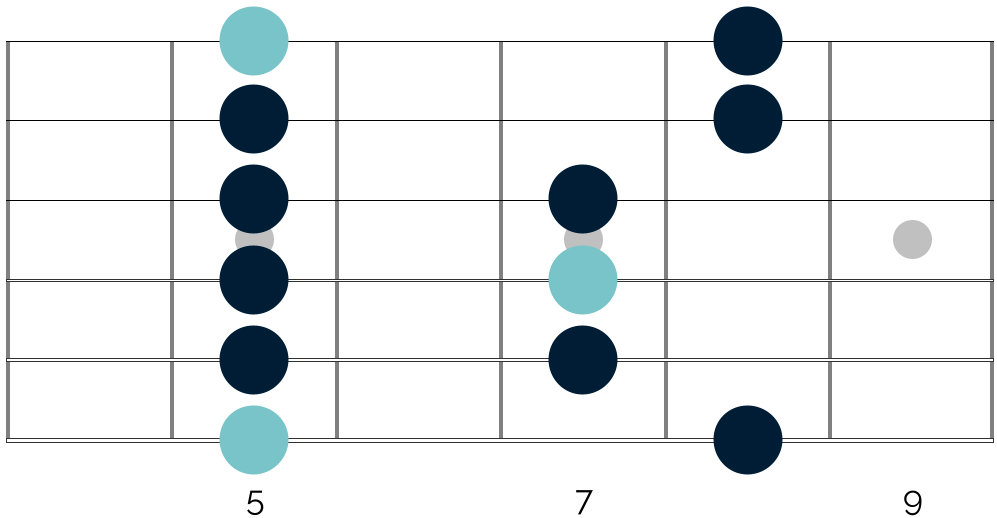
Hopefully you can see that these shapes are identical. The only difference is where they appear on the fretboard.
Similarly, the shape before shape 1 is always shape 5.
So if we stick with the key of A minor we can see that shape 5 appears twice – once at the 15th fret (as shown above) but also once starting on the 3rd fret, as shown below:
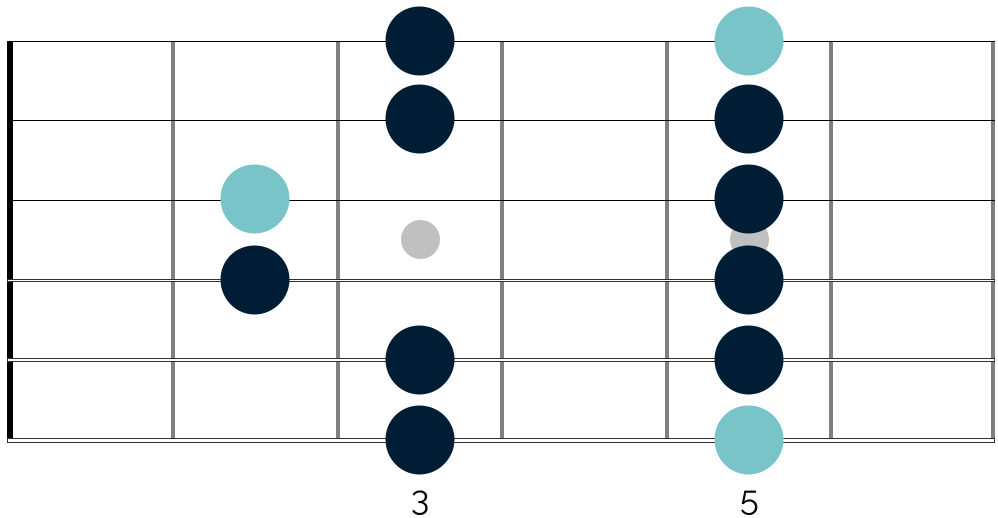
In this way, once you have a basic understanding of the different shapes of the minor pentatonic scale and how they fit together, it becomes easier to manoeuvre around the the fretboard.
Navigating the fretboard
One way to bring this idea to life is to look at all of the shapes of the A minor pentatonic scale laid out next to each other across the fretboard, as below:

At first glance the above diagram can look quite overwhelming.
If you can get past that though you will see that actually all it shows is 7 different positions of the A minor pentatonic scale laid out across the fretboard.
On the far left of the diagram, you have shape 5, which then goes on to shape 1, then shape 2 and so on.
The final shape at the far right of the diagram is also shape 1, but it is a whole octave higher than the first time the shape appears. The notes marked in light blue show all of the tonic notes of ‘A’ on the fretboard.
Hopefully this helps to illustrate the potential of the minor pentatonic scale. Learning these 5 shapes will ‘unlock’ the fretboard and allow you to manoeuvre across it freely.
Changing keys
At this point you may be wondering how to play the minor pentatonic scale in different keys.
After all up to now we have only looked at the shapes and positions of the scale in the key of A minor.
The great news, is that playing the minor pentatonic scale in different keys is pretty straight forward.
You just need to memorise the notes on your 6th string. These are as follows:

Once you’ve memorised the notes that are highlighted above, it becomes quite simple to apply the shapes of the A minor pentatonic scale to different keys.
You just have to follow these 3 easy steps:
1.) On the 6th string, find the root note of the key you’re playing in.
So if you are playing in the key of C minor, find the note of ‘C’ on your 6th string. If you are playing in the key of B minor, find the note of ‘B’ on your 6th string, and so on.
2.) That note will be the first note of the first shape of the minor pentatonic scale.
3.) Once you have established where you find shape 1 in any given key, you can use that to find where the other shapes will appear on the fretboard.
Let’s apply this to the key of G minor. If you are playing in G minor, this is where you would find shape 1 of the minor pentatonic scale:
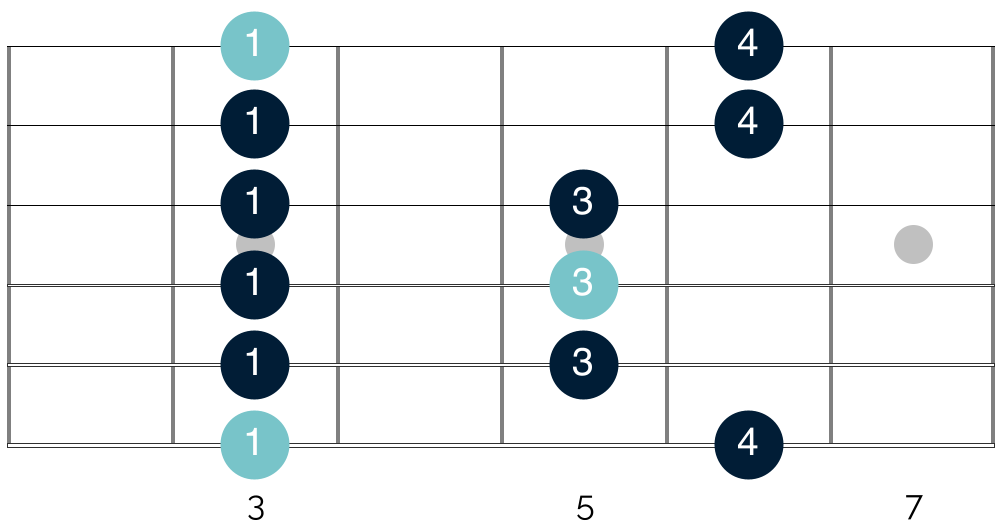
From this point you can then work out where the other shapes of the scale appear.
In G minor the second shape of the scale starts at the 6th fret and the third shape appears at the 8th fret.
In short, once you’ve found out where the first shape of the minor pentatonic scale is in any given key, you can quite quickly work out the rest of the shapes in that key.
You can apply this to any key.
Practicing the minor pentatonic scale
Given the importance of the minor pentatonic scale in blues and blues-rock music, I would recommend always including it in your guitar practice routine in some capacity.
There are 2 exercises that I regularly use to practice it. These are as follows:
Exercise 1
This first exercise works very well if this material is new to you and you are just getting to grips with the shapes listed above.
It is a very straight forward exercise. It simply involves playing the pentatonic shapes slowly along to the click of the metronome set at the lowest tempo you can manage.
This serves 2 purposes.
Firstly, it helps you to consolidate the minor pentatonic scale shapes all over the neck of your guitar.
Secondly, it helps you to develop greater rhythmic precision.
It is great to be able to play quickly, and if you are looking to play faster, then in this article here, I outline 8 exercises that will help improve your playing speed.
If you want to be a great guitarist however, you need to have an amazing sense of timing. This will help you to play in the pocket and lock into the groove.
To perform this exercise, set your metronome at a fairly low tempo of around 60 or 70 BPM.
Go through your minor pentatonic scale shapes, and play 2 notes for each click of the metronome. Do this in a variety of different keys.
Start at a level where you can comfortably play your scales in time. You should aim to play each note perfectly in sync with the click or beep of your metronome.
Once you have that nailed, reduce the BPM by a couple of beats and repeat the exercise.
Stick at this level until you can play each note in time. Reduce the BPM again and keep going. It will become more challenging the more you reduce the BPM.
I often use this as a warm up exercise to get my fingers moving and to improve my sense of timing and rhythm.
Exercise 2
The second exercise I like to include in my practice is slightly more technical. This involves taking each shape of the minor pentatonic scale, and playing it chromatically up and down your fretboard.
This is what the exercise looks like using the first shape of the minor pentatonic:
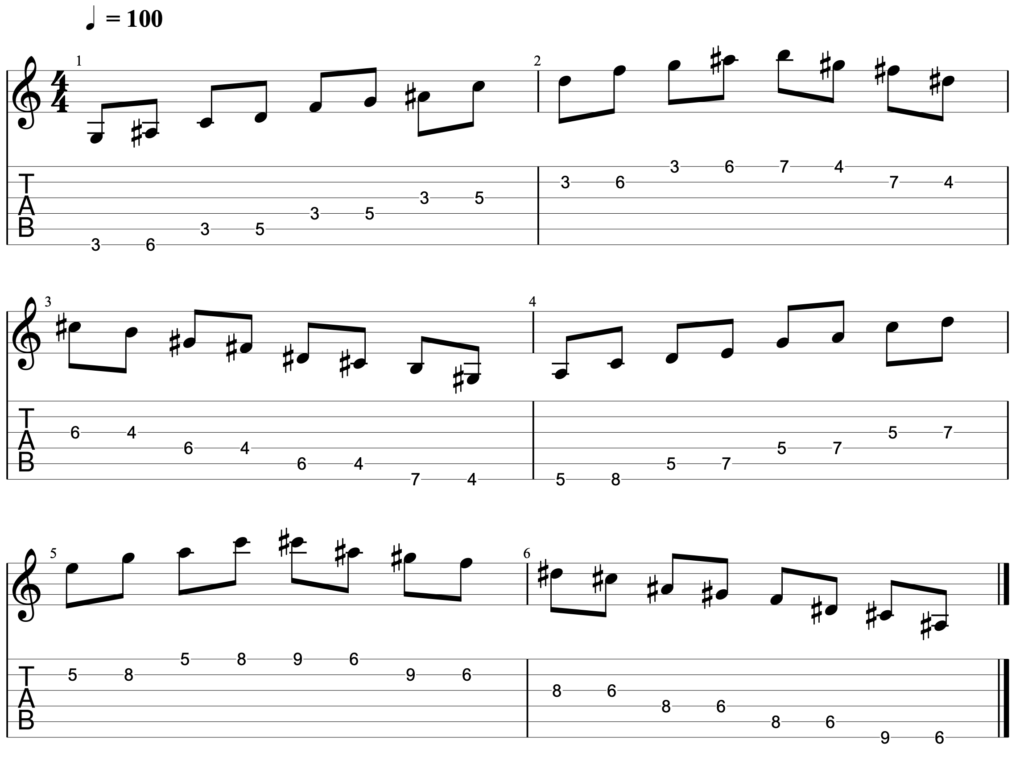
Start the exercise by playing shape 1 of the minor pentatonic scale. Begin at the 3rd fret, and work your way up the neck as shown above, until you reach the 15th fret.
Then without pausing, work your way back down to the 3rd fret. Once you have done that using the first shape of the minor pentatonic scale, move on to the second.
Go through all of the scale shapes in this way.
I recommend performing this exercise along to the click of a metronome.
Except this time play 4 notes for each click of the metronome. This is what the exercise sounds like, playing 4 notes per click at a tempo of 100 BPM:
Like the first exercise, this helps you to consolidate your minor pentatonic scale shapes. It also helps you to get used to playing them all over the fretboard.
Additionally, this exercise helps you to build speed and stamina in both your picking and fretting hands. This is because you don’t break the flow of your picking or fretting hands at all as you move between the different scale shapes.
Unlike the first exercise, I would recommend choosing a BPM that feels fast but manageable. You want to stretch yourself, without sacrificing accuracy and precision.
Once you can play all of the shapes at a particular tempo, up the BPM by a couple of beats. It will become more challenging the higher the BPM.
Using the minor pentatonic scale
As I mentioned earlier, part of what makes the minor pentatonic scale so popular is that you can use it in a lot of different soloing situations.
Some of these are a little more complex and beyond the scope of this article.
Fortunately though you don’t need to dig too deep into the theory or overcomplicate things at this point. There are 2 important musical contexts in which you can use the minor pentatonic scale. These are as follows:
When playing in a minor key
The first playing situation in which you can use the minor pentatonic is nice and straight forward. If you are playing a song in a minor key, you can solo using the corresponding minor pentatonic scale.
So if for example you are playing a song in B minor, you can solo and improvise using the B minor pentatonic scale.
If you are playing in the key of G minor, you can solo and improvise using the G minor pentatonic scale, and so on.
The notes that are found in the minor pentatonic correspond with those that appear in minor chords. Harmonically there are no clashes and so as a result you are safe to use the pentatonic scale in this way.
You can solo over all of the chords in a progression in a minor key and you will sound great.
When playing blues in a major key
Within a blues or blues-rock context, you can also solo using the minor pentatonic scale over a major chord progression.
From a theoretical point of view, this doesn’t make sense.
This is because the minor third that you find in the minor pentatonic scale clashes with the major third that you find in the chords in a major progression.
This creates dissonance, which is why traditional music theory advises against mixing minor and major tonalities in this way. However the clash that occurs between the tonalities is actually a key part of the blues sound.
As I outlined in more detail here, blues songs are usually built around a 12 bar chord progression. This chord progression is typically comprised of dominant 7th chords.
These chords are unusual, in that they blend the minor with the major. Specifically they contain the root note, a major third, perfect fifth, and a minor seventh.
This minor seventh clashes with the rest of the chord, creating a tense and unresolved sound.
This sound is not harsh on the ears, and in fact it creates a feeling that we now associate with the blues.
When you solo over a chord progression built from these chords, the minor pentatonic scale makes a great choice.
There is already a major/minor clash contained within the chords, and so the dissonance that you would normally create by playing the minor pentatonic over a major chord progression is diminished.
In fact, using the minor pentatonic just adds to that feeling of tension and will give your solos and improvisations a distinctly bluesy feeling.
As above, you can play the minor pentatonic over all of the chords in a major 12 bar blues progression and it will sound brilliant.
The minor pentatonic scale in context
To bring some of these ideas to life, below are some examples of blues and blues-rock riffs and guitar solos that are constructed using the minor pentatonic scale in different contexts:
- Jimi Hendrix uses the E minor pentatonic scale in his solo in ‘Hey Joe‘
- Billy Gibbons uses the A minor pentatonic scale to construct the riff in the song ‘La Grange‘
- Stevie Ray Vaughan plays the shape of the C minor pentatonic scale (but tunes down a half step to play in B) on his cover of ‘The Sky Is Crying‘
- Jimmy Page uses the E minor pentatonic scale in his solo in ‘Good Times Bad Times‘
- Eric Clapton plays the A minor pentatonic scale in his solo on the Beatles song, ‘While My Guitar Gently Weeps‘
- B.B. King plays the B minor pentatonic scale throughout the song, ‘The Thrill Is Gone‘.
The songs listed above are just some examples.
There are a whole range of famous blues and blues-rock songs that have solos and riffs that are constructed using the minor pentatonic scale.
Listen to these riffs and solos though and try to hear the minor pentatonic scale being played.
This will help you to develop a sense of how the scale sounds within the context of a song, and this will be useful when you start to create your own solos and improvisations.
Putting it all together
Well there we have it, everything that you need to know about the minor pentatonic scale.
I appreciate that there is a lot of information to take in here, and if this material is totally new to you, all of this information may feel a little overwhelming.
The key to learning it is to break it down into manageable chunks and to take your time.
It is much better to take a little longer learning the minor pentatonic scale – but to properly understand it – than it is to rush and fail to learn its shapes and uses properly.
When I first learnt the minor pentatonic scale, I solely focused on it for about 2 weeks.
These were the steps I took to really grasp the shapes of the scale and how to use it in the right context:
- To start with, I played the minor pentatonic shapes up and down the neck, in each of the different positions in A minor. I played the scale shapes along to a metronome, as described in exercise 1 above
- Once I had a solid grasp of the scales and positions of the A minor pentatonic scale, I put on an A minor blues backing track
- At first, I started by just playing the shapes of the A minor pentatonic scale over the backing track. I moved up and down the neck between each of the different positions
- Once I had that nailed, I started improvising over the backing track using the A minor pentatonic scale. My aim here was to ‘meander’ across the fretboard and move between each of the different positions as much as possible. This helped me to get familiar with the different shapes of the scale across the neck
- After I felt comfortable soloing in A minor, I repeated the process in B minor and C minor etc. I did this until I was familiar with the different positions of the minor pentatonic scale in these alternate keys
The process may sound quite long winded, but in fact it was a lot of fun.
For the most part I was just jamming along to backing tracks. This brought the scale to life and helped me to engrain the shapes in a more musical and practical way.
If you are finding it tricky to remember each of the shapes and apply them in different keys, give this a go.
I think it will really help you to consolidate the scale shapes and to start using them in a practical playing context.
Good luck!
Let me know how you get on, and if you have questions, drop a note in the comments section, or send me an email on aidan@happybluesman.com. I’d love to help.
If you would like to further develop your understanding of the minor pentatonic scale, consider joining The Blues Club.
There are a range of courses inside the Blues Club which cover this topic in much more detail, and which will help you to start soloing and making music with the minor pentatonic scale.
I hope to see you in there! 😁
References
Justin Guitar, Simplifying Theory, Jazz Guitar Licks, Simplifying Theory, Fret Jam, Guitar Music Theory, Fret Jam, Guitar Music Theory, Guitar Habits, Guitar Music Theory, Justin Guitar, Wikipedia, Complete Guide to Playing Blues Guitar, Fret Jam
Images
Unsplash, Donner Deal
Photo of Jimmy Page – Jim Summaria (Wikimedia Commons. The licence for the photo can be found here)





Responses
First of all – LOVE your site! Amazing content.
In the initial Shape 2 section you have the root notes marked on the wrong strings – G and e rather than D and B.
Thank you so much for the kind comment Kelly – I am so happy to hear you are enjoying the content on the site. Thank you also for the spot and for letting me know, I’ve just changed it above now! 😁
Hi
Thanks for a great website.
So many good advices learning minor pentatonic scales. In particular: starting SLOW!!!
best
Henrik
Hi Henrik, thanks so much for the kind words – they made my day! I’m really glad to hear that you found the article on the minor pentatonic scale useful 😁 Best of luck with learning it, and if you have any questions about it or if there is anything else at all that I can help with, just send me an email on aidan@happybluesman.com and I’m always happy to help! Cheers, Aidan
Dude,
Seriously I have been trying to figure out the scale progressions for a few months. Most teachers, and there are some good ones, only show the 5 positions of the pentatonic scale and usually the Am scale from the 5th fret up but no one except u explained about going down the neck and how it went from 1st position to 5th etc..makes sense but no one made it as clear as you have. Thanks
Hi Jerry, thanks so much for the kind words man, I really appreciate it I am so glad to hear that you found the article useful. It can be tricky to get to grips with the shapes at first, but once you have a handle on them, they will really open up your guitar fretboard, and make playing lead guitar and soloing so much easier (and more fun!)
If you do have any more questions about the minor pentatonic scale though, or if there is anything else I can help you with, just let me know. You can reach me whenever on aidan@happybluesman.com and I’m always around to help. Thanks so much and best of luck with getting to grips with everything!
Hi
This was the greatest explanation on minor pentatonic !!! I have been looking for this explanation forever and finally found it! I have been practicing the shapes for years but couldn’t understand the why, what or how ! You have totally out done the internet’s attempt at minor pentatonic explaining. I whole heartedly THANK YOU SO MUCH !!! and really truly appreciate it !
Thanks for sharing!
Joe
Wow Joe – thank you so much for taking the time to write such a kind comment. It made my day! I am really glad that you found the article helpful and that you feel more comfortable with the shapes of the minor pentatonic. Understanding how they work and how you can use them to improvise will transform your guitar playing and go a huge way towards helping you move freely around your fretboard.
If you do have any more questions though – or if there is anything else at all I can help with, just send me an email. You can reach me on aidan@happybluesman.com and I’m always around and happy to help Thanks again.
O e of the most useful articles to put in oractice the minor pentatonic. Thanks so much. Will start this afternoon.
Thank you so much for taking the time to comment Elisabet. I’m very glad to hear you found the article helpful! Best of luck getting to grips with the shapes of the minor pentatonic scale. And if you do ever have any questions about them – or any other element of your playing – just send me an email on aidan@happybluesman.com. I am always around and happy to help!
Phenomenal article Mr Bluesman. I stumbled across this article today while looking for an image of the minor pentatonic shapes on google. Now I’ve learned and understand the shapes I am already having so much fun jamming to some backing tracks on YouTube. Up until today it was like playing darts in the dark. You’ve turned on the light! Thank you good sir
Wow – thank you for taking the time to write such a kind comment John, I really appreciate it. I am so glad to hear that you feel more comfortable using the shapes now, and that you’re having fun jamming to some backing tracks. I remember having the same feeling of going from fumbling around in the dark on the fretboard to being able to play with confidence. And it feels amazing! Best of luck with continuing to jam and play with the minor pentatonic, and if you have any questions, please do send them over. You can reach me on aidan@happybluesman.com and I am always around and happy to help!
I’ve been struggling with the pentatonic scales and your explanation here clarified it all for me. I’m going to practice these scales and shapes and I look forward to be empowered with understanding the fretboard so much more with this information. Thanks so much!!!
Thanks very much for the comment and the kind words Chris. I am so glad to hear that you found the article helpful and that it is allowing you to move around the fretboard with greater freedom. I remember when I first learnt the minor pentatonic scale shapes; it immediately made me feel so much more confident and really pushed my playing onto the next level, and I am sure that it will do the same for you 😁
If you do have any questions about your playing that I can help with though, please do just send them over. You can reach me on aidan@happybluesman.com and I am always around and happy to help!
Hi, great article, I found it really useful. as for remembering the shapes, I recently came across this video on YouTube that creates a story associated with the shapes and it has taught me the pentatonic shapes in the 12 and a half minutes of watching the video. I picked up my guitar later on the morning after watching it and could do all the shapes from memory! The theory behind as you explain is needed, but just for remembering the shapes using the story and pictures did it for me. Hope you find it interesting https://youtu.be/swVfdpaoIWo?si=d6vhWMsbqeRGtaJ9 (hopefully the link works, if not the channel was https://youtube.com/@jeanlejeune2288?si=j6zpjjt4J5e5LpyA )
This is the the best penatonic scale info ive found on the net and ive search for a long time its easy to understand
Thank you so much for the kind words Mark, and I am so happy to hear that you found it helpful. Best of luck with getting to grips with the scale! 😁